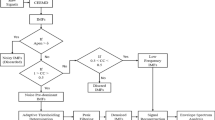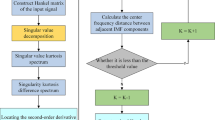Abstract
To address challenges in fault diagnosis of rolling bearing caused by great noise contamination and difficult extraction of fault character frequency, a fault diagnosis method of rolling bearing based on the maximum correlation kurtosis deconvolution (MCKD), singular spectral decomposition (SSD) and teager energy operator (TEO) with optimal parameters was proposed in this study. First of all, denoising was performed as a preprocessing to the original vibration signals which were collected by using the MCKD with optimal parameters to highlight the impact component. Next, SSD was performed to the preprocessed signals and the optimal components were selected according to variance contribution. Finally, the energy spectra of optimal components were calculated and characteristic frequency was extracted to realize fault diagnosis of bearing. Through simulation and experimental analysis, the proposed method was proved feasible. It was further compared with empirical mode decomposition (EMD) and ensemble empirical mode decomposition (EEMD), which proved superiority and validity of the proposed method.
Similar content being viewed by others
References
B. Yang et al., Early fault feature extraction of Rolling Bearing Based on med-rssd, Mechanical Transmission, 42(6) (2018) 120–128.
Y. Zhu et al., Weak fault feature identification of rolling bearings based on swd and momeda, Bearing (6) (2021) 38–43.
B. Yang et al., Application of optimal parameter mckd and elmd in bearing composite fault diagnosis, Vibration and Impact, 38(11) (2019) 59–67.
X. Zhu and Y. Wang, Early fault diag-nosis of rolling bearing based on autocorr elation analysis and mckd, Vibration and Impact, 24(38) (2019) 183–188.
G. Tang and X. Wang, Maximum associatedcliff deconvolution combined with 1.5 dimensi- onal spectrum of rolling bearing early fault feature extraction method, Vibration and Impact, 34(12) (2015) 79–84.
B. Yang et al., Application of maximum associated crg deconvolution in failure diagnosis of coal arer, Mine Machinery, 49(1) (2021) 14–18.
W. Zhang et al., Application of adaptive local iterative filtering and permutation entropy in gear fault recognition, Hindawi, Mathematical Problems in Engineering, 2021 (2021) 1–12.
Q. Gao et al., Research on the emd diagnostic method of the rolling bearing fault, Journal of Vibration Engineering, 20(1) (2007) 15–18.
H. LI et al., EEMD and the optimized band entropy were applied to bearing fault feature extraction, Journal of Vibration Engineering, 33(2) (2020) 414–423.
K. Liang et al., Study on bearing fault feature extraction based on improved ceemdan and optimized reconstruction, Mechanical Intensities, 41(3) (2019) 532–539.
P. Bonizzi et al., Singular spectrum decomposition: a new method for time series decomposition, Advances in Adaptive Data Analysis, 6(4) (2014) 1–34.
X. Shang et al., Classification of microshock and blasting signal based on EMDSVD, Journal of Geotechnical Engineering, 38(10) (2016) 1849–1858.
S. Liu et al., Study on improved mckd method and early fault diagnosis of bearings, Mechanical Design and Manufacturing, 5 (2021) 56–58.
D. Tang et al., Study on weak diagnosis of planetary gearbox in MCKD based on parameter optimization, Electromechanical Engineering, 35(8) (2018) 779–785.
C. Bandt and B. Pompe, Permutation entropy: a natural complexity measure for time series, Physical Review Letters, 88(17) (2002) 174102.
G. L. Mcdonald, Q. Zhao and M. J. Zhou, Maximun correlated kurtosis dexonvolution and application on gear tooth chip fault detection, Mechanical Systems and Signal Processing, 33 (2012) 237–255.
H. LI et al., Study on the dynamic response fusion method of discharge structure based on variance contribution rate, Vibration and Impact, 34(19) (2015) 181–191.
G. Tang and X. Wang, IVMD fusion singular differential spectrum of rolling bearing early fault diagnosis, Vibration, Test and Diagnosis, 36(4) (2016) 700–707+810.
H. Zhang et al., Research on fault diagnosis of rolling bearings based on FDM and TEO, Mechanical and Electrical Engineering, 38(7) (2021) 850–856.
Acknowledgments
This work was supported by the National Natural Science Foundation of China (51769007), Yunnan Provincial Local Undergraduate College Basic Research Joint Special Key Project (202001BA070001-002), and Xingdian Talents Support Program (YNWR-QNBJ-2018-349).
Author information
Authors and Affiliations
Corresponding author
Additional information
Ben Cui studied at Kunming University of Science and Technology, master’s degree. His main research direction is fault diagnosis of rotating machinery.
Wenbin Zhang obtained a doctorate degree from Zhejiang University, Professor. His main research interests are pattern recognition and intelligent diagnosis.
Rights and permissions
About this article
Cite this article
Cui, B., Guo, P. & Zhang, W. Research on fault diagnosis of rolling bearing based on the MCKD-SSD-TEO with optimal parameters. J Mech Sci Technol 37, 31–42 (2023). https://doi.org/10.1007/s12206-022-1205-4
Received:
Revised:
Accepted:
Published:
Issue Date:
DOI: https://doi.org/10.1007/s12206-022-1205-4




